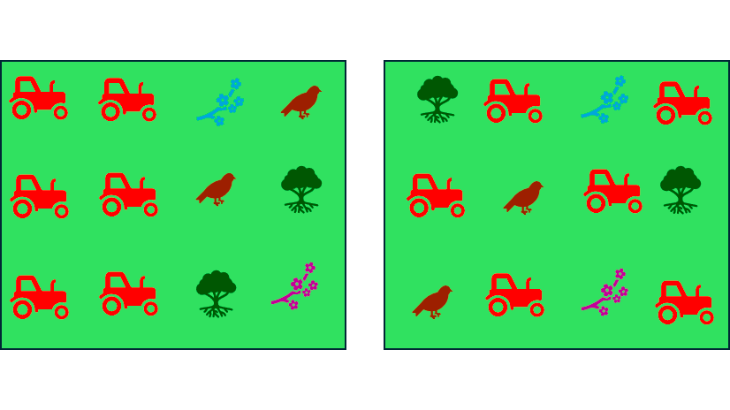Land Share or Land Spare?

Scotland, Wales and Northern Ireland have land use strategies. There is no land use strategy for England1. This makes it difficult to take consistent decisions on how much land should be devoted to crop production, forestry, bio-diversity/ nature, recreation, transport, housing, industry, water and so on. The decision is doubly complicated because much land can serve more than one purpose. Last year there was a debate in Long Buckby Library entitled ‘Farming and Wildlife Conservation: are they compatible’. Sadly I missed it, but it is part of a national debate on Land Sparing vs Land Sharing which is very important in developing and funding a land use strategy.
Definitions2:
· Land Sharing: a situation where low-yield farming enables biodiversity to be maintained within the whole agricultural landscape.
· Land Sparing: where we make some farmland as productive as possible, requiring a smaller area of land to attain the same yields thus freeing up other land for environmental projects. This leaves greater areas of natural habitat untouched.

Self-sufficiency
In 2022, UK self-sufficiency in all food was 60% and in indigenous food it was 73%3. From 1940–80, the UK went from being 30% to 80% self-sufficient in crops and became a net exporter of grains3. But it has dropped back since. Recent world events have re-awakened the need for national food security and this entails a level of self-sufficiency in certain crops. At the recent National Farmers’ Union Conference (Feb 2024), Rishi Sunak reaffirmed the target for UK self-sufficiency in food.
Agriculture takes up 70% of the UK’s land mass4. On land used to feed us, 85% grows grass or crops to feed to animals4. Only 15% of our land grows crops for direct human consumption4. However, the feed conversion ratio (FCR) of UK livestock varies greatly.
The FCR calculation is relatively straightforward in that it needs two pieces of information:
The total amount of feed (kg) fed within a given period
The total amount of meat finished (kg) within a given period
These figures are divided (amount of feed ÷ amount of finished meat) to produce a figure (always greater than 1) of how many kilograms (kg) of feed it takes to produce 1 kg of meat. Lower FCR values indicate higher efficiency. FCRs are typically 6.0–10.0 for beef, 2.7–5.0 for pigs, 1.7–2.0 for chicken and 1.0–2.4 for farmed fish and shrimp. However caution is needed in interpreting these figures: for example, the cows may be eating home-grown grass, but the chickens may be eating imported soya.
Alternative uses of farmland depend on soil type, topography, climate and rainfall. Small fields and steep gradients cannot accommodate large machinery. In general the UK grows good grass in the west where the rainfall is high and arable crops in the east where the rainfall is low. Humans cannot eat grass. Nevertheless, FCRs show that reducing one’s overall consumption of meat, without necessarily going vegetarian or vegan, must be a good option.
The Case for Land Sparing
The least bad way forward for most species worldwide turns out to be Land Sparing rather than Land Sharing5,6. That is, for biodiversity, Land Sparing is better than Land Sharing. By producing more food from a smaller area, you create the necessary elbow room for all the other purposes required of our land.
Over the last 30 years, farmers have neglected their most important asset, their soil. No-till agriculture and regenerative farming techniques are now being applied to reinstate soil fertility. Cover crops, crop rotations including legumes, animal manure and grazing can all improve soil texture, increase moisture holding capacity, add to soil organic matter, sequester carbon and ultimately improve yields whilst benefiting the climate. These farming practices are compatible with both Land Sharing and Land Sparing.
In Land Sparing, careful and scientific use of inputs such as fertilisers and pesticides can further increase yields without necessarily causing pollution and harming wildlife (note, however, that current methods of manufacturing nitrogen fertilisers from natural gas are not sustainable).
Following the introduction of the Environment Land Management Scheme (ELMS), farmers and land managers are having second thoughts about Land Sharing. There has been poor uptake of the Sustainable Farming Incentive, but this may change with higher grants recently introduced.
Re-wilding, organic farming and some so-called ‘nature friendly farming’ measures included in ELMS risk worsening the global environmental crisis by reducing how much food is produced in a region, driving up food imports and increasing environmental damage overseas. Lower yields from organic farming and Land Sharing will increase the area of land needed to achieve 60% self-sufficiency. Organic farming comes at a cost: organic food is more expensive in the shops; organic growing is detrimental to the cost of living.
And so, as James Borell says2, “uncomfortable as it might be, the uncomfortable truth is that intensive agriculture is the way to go.”
What is needed:
1. A viable Land Use Strategy for England.
2. A review of support to UK farmers to maintain national self-sufficiency above 60% (partly implemented as of January 2024).
3. A national agricultural policy of Land Sparing and changes to ELMS to reflect this.
4. Where suitable land is available, farmers should be encouraged to grow alternative protein sources to meat.
5. Investment in low carbon fertiliser production should be encouraged.
References:
1. House of Lords. Land use frameworks: integrating policies in England. Available at: https://lordslibrary.parliament.uk/land-use-frameworks-integrating-policies-in-england/
2. Dr James Borrell. Good Ideas In Conservation #1: Land Sparing vs Land Sharing. Available at: http://www.jamesborrell.com/good-ideas-in-conservation-1-land-sparing-vs-land-sharing/
3. National Statistics. Agriculture in the United Kingdome 2022. Available at: https://assets.publishing.service.gov.uk/government/uploads/system/uploads/attachment_data/file/1170953/auk-2022-13jul23i.pdf
4. Henry Dimbleby. ‘Making the most of our land’. Chapter 15 in ‘Ravenous’. Profile Books 2023.
5. Ian Bateman and Andrew Balmford. Current conservation policies risk accelerating biodiversity loss. Nature 618, 671-674 (2023) (as discussed in: Current conservation policies risk damaging global biodiversity, researchers argue. Available at: https://news.exeter.ac.uk/faculty-of-environment-science-and-economy/current-conservation-policies-risk-damaging-global-biodiversity-researchers-argue/
6. Graham Brookes. Why ‘land sparing’ is a more sustainable option. Available at: https://www.fruitnet.com/fresh-produce-journal/comment-why-land-sparing-is-a-more-sustainable-option/255386.article

